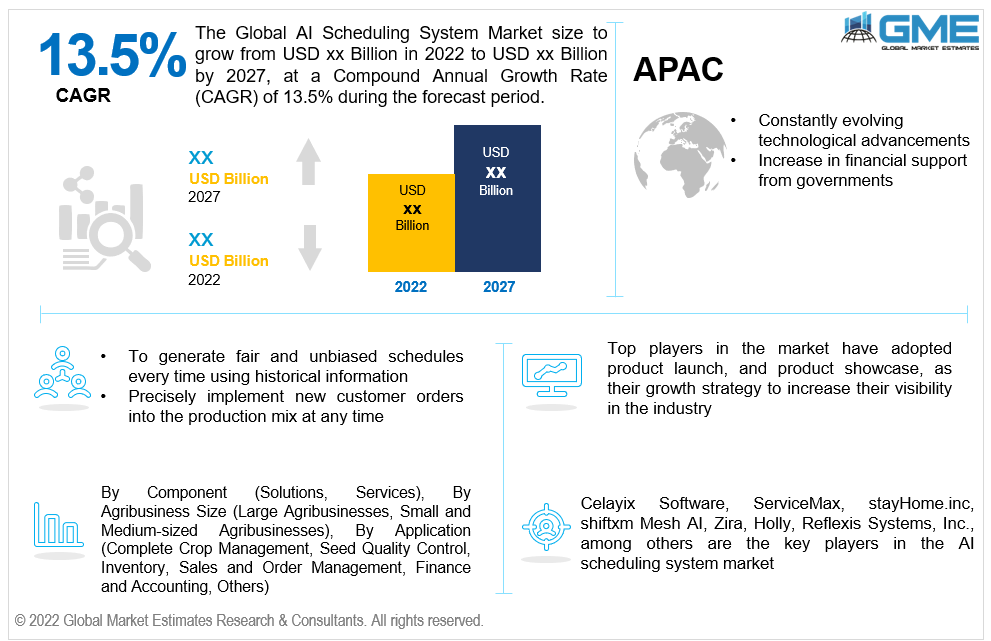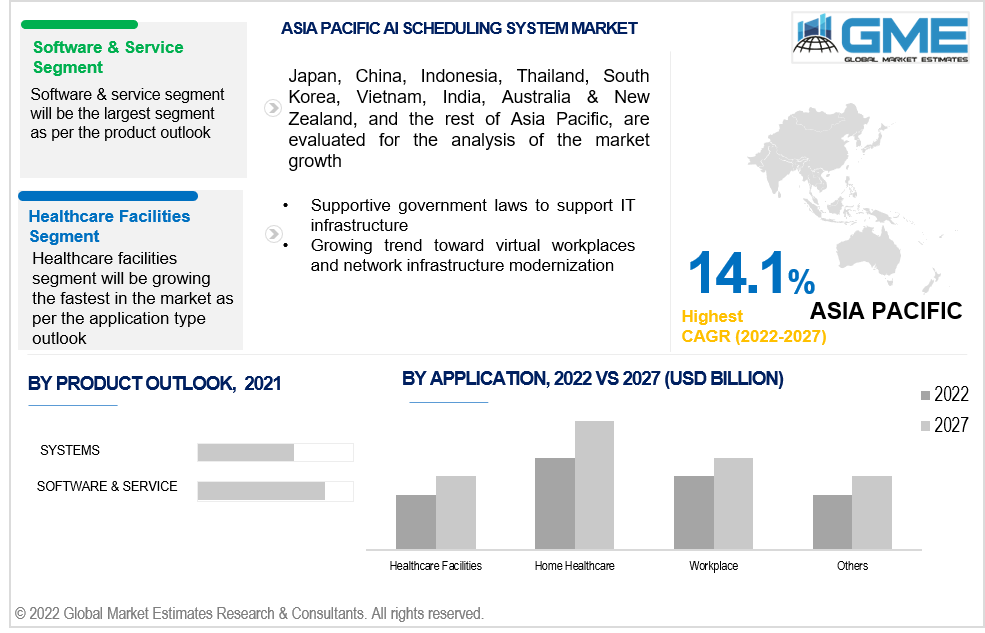
Global AI Scheduling System Market Size, Trends & Analysis - Forecasts to 2027 By Product (Systems, Software & Service), By Application (Healthcare Facilities, Home Healthcare, Workplace, and Others), By Region (North America, Asia Pacific, CSA, Europe, and the Middle East and Africa), Competitive Landscape Company Market Share Analysis, and Competitor Analysis
The Global AI Scheduling System Market is projected to grow at a CAGR value of 13.5% from 2022 to 2027. AI is well-known in the business world for its vast potential to optimize a wide range of corporate tasks. According to our research, the use of AI in businesses has increased by 270% in the last four years. The deployment of AI-driven employee scheduling software to generate fair and unbiased schedules every time using historical information obtained through machine learning, including the use of AI for supervised learning such as pictures, multimedia, message, and input audio handling, will propel market growth.
The ability of real-time AI-based scheduling to implement new customer orders into the production mix at any time and have them prioritized appropriately as they compete for human and machinery resources in each work station, as well as the versatile variation in the accessibility of these resources to produce a quasi-optimal schedule, is driving the market growth. The most significant advantage of real-time AI-based scheduling is that it relieves managers and supervisors with a considerable amount of labor in attempting to constantly.
Following the pandemic, the market is projected to see a modest drop in year-over-year growth owing to the lockdowns and shifting objectives of many industries, this is partly related to the disrupted supply chains and limited adoption of AI in various end-user industries in 2020. The ongoing COVID-19 outbreak has caused economic problems. It is indeed going to wreak havoc on supply chains, forcing businesses and entire industries to rethink and adapt to the supply chain paradigm.

Based on the product scope, the AI scheduling system market is segmented into systems and software & service. The software & service segment is expected to hold the largest piece of the market during the forecast period. This growth could be ascribed to the fact that AI software facilitates the performance of previously complex operations without large expense outlays, operates 24 hours a day, seven days a week, with no interruptions or downtime, assists in repetitive work, and eliminates human mistakes.
Based on the application in AI scheduling systems, the market is segmented into healthcare facilities, home healthcare, workplace, and others. The healthcare facilities segment is expected to grow the fastest in the AI Scheduling System market from 2022 to 2027. The increased adoption of a methodical approach by healthcare providers, as well as a scarcity of medical staff and doctors, are likely to drive the expansion of the medical scheduling software in the healthcare industry.

As per the geographical analysis, the AI scheduling system market can be classified into North America (the United States, Canada, and Mexico), Asia Pacific (India, China, Japan, Malaysia, Singapore, and the Rest of Asia Pacific), Europe (Germany, United Kingdom, Italy, France, Spain, Netherlands, and Rest of Europe), Middle East & Africa (Saudi Arabia, United Arab Emirates, and Rest of the Middle East & Africa) and Central & South America (Brazil, Argentina, and Rest of Central and South America).
North America (the United States, Canada, and Mexico), will have a dominant share in the AI Scheduling System market from 2022 to 2027. The region’s strong licensing laws, greater spending on research and development on innovative technologies, increased adaptation to advanced cloud-based technologies, and a larger concentration of players in these countries are contributing to regional growth.
The APAC region is expected to showcase the fastest growth rate among all regions. The growing trend toward virtual workplaces and network infrastructure modernization and adoption of artificial intelligence and natural language processing integration in AI scheduling software. Also, continuous technological advancements, financial support from governments in the region, and an extensive industrial base are boosting the market growth in this region.
Celayix Software, ServiceMax, stayHome.inc, shiftx, Mesh AI, Zira, Holly, Reflexis Systems, Inc., among others are the key players in the AI scheduling system market.
Please note: This is not an exhaustive list of companies profiled in the report.
Chapter 1 Methodology
1.1 Market Scope & Definitions
1.2 Estimates & Forecast Calculation
1.3 Historical Data Overview and Validation
1.4 Data Sources
1.4.1 Secondary
1.4.2 Primary
Chapter 2 Report Outlook
2.1 AI Scheduling System Industry Overview, 2022-2027
2.1.1 Industry Overview
2.1.2 Product Overview
2.1.3 Application Overview
2.1.4 Regional Overview
Chapter 3 AI Scheduling System Market Trends
3.1 Market Segmentation
3.2 Industry Background, 2022-2027
3.3 Market Key Trends
3.3.1 Positive Trends
3.3.1.1 Precisely implement new customer orders into the production mix at any time
3.3.2 Industry Challenges
3.3.2.1 Integrating AI solutions into current systems is a challenging undertaking
3.4 Prospective Growth Scenario
3.4.1 Product Growth Scenario
3.4.2 Application Growth Scenario
3.5 COVID-19 Influence over Industry Growth
3.6 Porter’s Analysis
3.7 PESTEL Analysis
3.8 Value Chain & Supply Chain Analysis
3.9 Regulatory Framework
3.9.1 North America
3.9.2 Europe
3.9.3 APAC
3.9.4 LATAM
3.9.5 MEA
3.10 End-User Overview
3.11 Market Share Analysis, 2021
3.11.1 Company Positioning Overview, 2021
Chapter 4 AI Scheduling System Market, By Product
4.1 Product Outlook
4.2 Systems
4.2.1 Market Size, By Region, 2022-2027 (USD Billion)
4.3 Software & Service
4.3.1 Market Size, By Region, 2022-2027 (USD Billion)
Chapter 5 AI Scheduling System Market, By Application
5.1 Application Outlook
5.2 Healthcare Facilities
5.2.1 Market Size, By Region, 2022-2027 (USD Billion)
5.3 Home Healthcare
5.3.1 Market Size, By Region, 2022-2027 (USD Billion)
5.4 Workplace
5.4.1 Market Size, By Region, 2022-2027 (USD Billion)
5.5 Others
5.5.1 Market Size, By Region, 2022-2027 (USD Billion)
Chapter 6 AI Scheduling System Market, By Region
6.1 Regional outlook
6.2 North America
6.2.1 Market Size, By Country 2022-2027 (USD Billion)
6.2.2 Market Size, By Product, 2022-2027 (USD Billion)
6.2.3 Market Size, By Application, 2022-2027 (USD Billion)
6.2.4 U.S.
6.2.4.1 Market Size, By Product, 2022-2027 (USD Billion)
6.2.4.2 Market Size, By Application, 2022-2027 (USD Billion)
6.2.5 Canada
6.2.5.1 Market Size, By Product, 2022-2027 (USD Billion)
6.2.5.2 Market Size, By Application, 2022-2027 (USD Billion)
6.3 Europe
6.3.1 Market Size, By Country 2022-2027 (USD Billion)
6.3.2 Market Size, By Product, 2022-2027 (USD Billion)
6.3.3 Market Size, By Application, 2022-2027 (USD Billion)
6.3.4 Germany
6.3.4.1 Market Size, By Product, 2022-2027 (USD Billion)
6.3.4.2 Market Size, By Application, 2022-2027 (USD Billion)
6.3.5 UK
6.3.5.1 Market Size, By Product, 2022-2027 (USD Billion)
6.3.5.2 Market Size, By Application, 2022-2027 (USD Billion)
6.3.6 France
6.3.6.1 Market Size, By Product, 2022-2027 (USD Billion)
6.3.6.2 Market Size, By Application, 2022-2027 (USD Billion)
6.3.7 Italy
6.3.7.1 Market Size, By Product, 2022-2027 (USD Billion)
6.3.7.2 Market Size, By Application, 2022-2027 (USD Billion)
6.3.8 Spain
6.3.8.1 Market Size, By Product, 2022-2027 (USD Billion)
6.3.8.2 Market Size, By Application, 2022-2027 (USD Billion)
6.3.9 Russia
6.3.9.1 Market Size, By Product, 2022-2027 (USD Billion)
6.3.9.2 Market Size, By Application, 2022-2027 (USD Billion)
6.4 Asia Pacific
6.4.1 Market Size, By Country 2022-2027 (USD Billion)
6.4.2 Market Size, By Product, 2022-2027 (USD Billion)
6.4.3 Market Size, By Application, 2022-2027 (USD Billion)
6.4.4 China
6.4.4.1 Market Size, By Product, 2022-2027 (USD Billion)
6.4.4.2 Market Size, By Application, 2022-2027 (USD Billion)
6.4.5 India
6.4.5.1 Market Size, By Product, 2022-2027 (USD Billion)
6.4.5.2 Market Size, By Application, 2022-2027 (USD Billion)
6.4.6 Japan
6.4.6.1 Market Size, By Product, 2022-2027 (USD Billion)
6.4.6.2 Market Size, By Application, 2022-2027 (USD Billion)
6.4.7 Australia
6.4.7.1 Market Size, By Product, 2022-2027 (USD Billion)
6.4.7.2 Market size, By Application, 2022-2027 (USD Billion)
6.4.8 South Korea
6.4.8.1 Market Size, By Product, 2022-2027 (USD Billion)
6.4.8.2 Market Size, By Application, 2022-2027 (USD Billion)
6.5 Latin America
6.5.1 Market Size, By Country 2022-2027 (USD Billion)
6.5.2 Market Size, By Product, 2022-2027 (USD Billion)
6.5.3 Market Size, By Application, 2022-2027 (USD Billion)
6.5.4 Brazil
6.5.4.1 Market Size, By Product, 2022-2027 (USD Billion)
6.5.4.2 Market Size, By Application, 2022-2027 (USD Billion)
6.5.5 Mexico
6.5.5.1 Market Size, By Product, 2022-2027 (USD Billion)
6.5.5.2 Market Size, By Application, 2022-2027 (USD Billion)
6.5.6 Argentina
6.5.6.1 Market Size, By Product, 2022-2027 (USD Billion)
6.5.6.2 Market Size, By Application, 2022-2027 (USD Billion)
6.6 MEA
6.6.1 Market Size, By Country 2022-2027 (USD Billion)
6.6.2 Market Size, By Product, 2022-2027 (USD Billion)
6.6.3 Market Size, By Application, 2022-2027 (USD Billion)
6.6.4 Saudi Arabia
6.6.4.1 Market Size, By Product, 2022-2027 (USD Billion)
6.6.4.2 Market Size, By Application, 2022-2027 (USD Billion)
6.6.5 UAE
6.6.5.1 Market Size, By Product, 2022-2027 (USD Billion)
6.6.5.2 Market Size, By Application, 2022-2027 (USD Billion)
6.6.6 South Africa
6.6.6.1 Market Size, By Product, 2022-2027 (USD Billion)
6.6.6.2 Market Size, By Application, 2022-2027 (USD Billion)
Chapter 7 Company Landscape
7.1 Competitive Analysis, 2022
7.2 Celayix Software
7.2.1 Company Overview
7.2.2 Financial Analysis
7.2.3 Strategic Positioning
7.2.4 Info Graphic Analysis
7.3 ServiceMax
7.3.1 Company Overview
7.3.2 Financial Analysis
7.3.3 Strategic Positioning
7.3.4 Info Graphic Analysis
7.4 stayHome.inc
7.4.1 Company Overview
7.4.2 Financial Analysis
7.4.3 Strategic Positioning
7.4.4 Info Graphic Analysis
7.5 shiftx
7.5.1 Company Overview
7.5.2 Financial Analysis
7.5.3 Strategic Positioning
7.5.4 Info Graphic Analysis
7.6 Mesh AI
7.6.1 Company Overview
7.6.2 Financial Analysis
7.6.3 Strategic Positioning
7.6.4 Info Graphic Analysis
7.7 Zira
7.7.1 Company Overview
7.7.2 Financial Analysis
7.7.3 Strategic Positioning
7.7.4 Info Graphic Analysis
7.8 Holly
7.8.1 Company Overview
7.8.2 Financial Analysis
7.8.3 Strategic Positioning
7.8.4 Info Graphic Analysis
7.9 Reflexis Systems, Inc.
7.9.1 Company Overview
7.9.2 Financial Analysis
7.9.3 Strategic Positioning
7.9.4 Info Graphic Analysis
7.10 Other Companies
7.10.1 Company Overview
7.10.2 Financial Analysis
7.10.3 Strategic Positioning
7.10.4 Info Graphic Analysis
The Global AI Scheduling System Market has been studied from the year 2019 till 2027. However, the CAGR provided in the report is from the year 2022 to 2027. The research methodology involved three stages: Desk research, Primary research, and Analysis & Output from the entire research process.

The desk research involved a robust background study which meant referring to paid and unpaid databases to understand the market dynamics; mapping contracts from press releases; identifying the key players in the market, studying their product portfolio, competition level, annual reports/SEC filings & investor presentations; and learning the demand and supply-side analysis for the AI Scheduling System Market.

The primary research activity included telephonic conversations with more than 50 tier 1 industry consultants, distributors, and end-use product manufacturers.

Finally, based on the above thorough research process, an in-depth analysis was carried out considering the following aspects: market attractiveness, current & future market trends, market share analysis, SWOT analysis of the company and customer analytics.

Frequently Asked Questions
Tailor made solutions just for you
80% of our clients seek made-to-order reports. How do you want us to tailor yours?
OUR CLIENTS